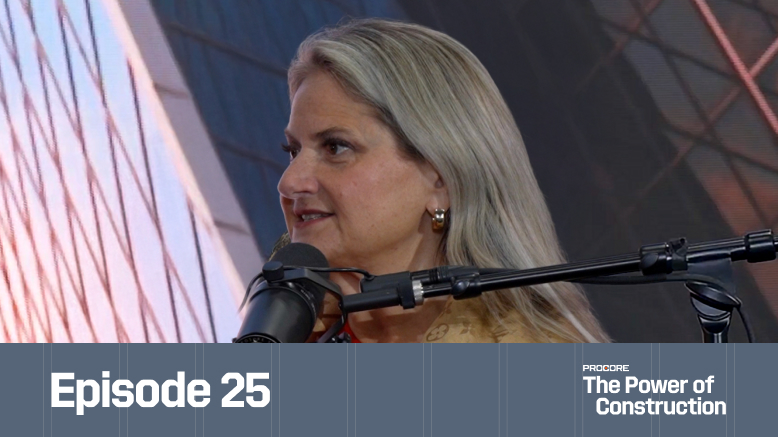— 9 min read
Construction Financial Ratios: Measuring Project and Business Health


Last Updated Aug 28, 2024

TJ Forbes
Senior Solutions Engineer
19 articles
TJ Forbes is a Senior Solutions Engineer at Procore, specializing in financials products, analytics, ERP integrations, workflows, reporting and accounting solutions. He previously worked as a financial manager and project accountant for Stiles, a commercial real estate firm in Ft. Lauderdale. TJ holds a Masters in Financial Management from Southern Adventist University.

Kristen Frisa
Contributing Writer
111 articles
Kristen Frisa is a contributing writer for Procore. She also contributes to a variety of industry publications as a freelance writer focused on finance and construction technology. Kristen holds a Bachelor of Arts in Philosophy and History from Western University, with a post-graduate certificate in journalism from Sheridan College. She lives in Ontario, Canada.
Last Updated Aug 28, 2024

When profit margins are small and risk is high, financial managers for construction companies need all of the data they can get to keep the business afloat. Similar to using a thermometer to detect a fever, financial ratios are the key tools for analyzing the health of a construction business. While some financial ratios are used to monitor the health of businesses in all industries, the construction industry requires specific monitoring to determine a project’s or business’ success.
This article will discuss the key financial ratios construction project managers can use to monitor and adjust their projects for the best possible outcomes.
Table of contents
How are construction financial ratios used?
Financial ratios are calculations using two measurements that allow managers to identify specific metrics on a project.
Imagine the schedule and the budget as presets construction managers can use for their projects. Using these metrics would be like setting the GPS and the cruise control on a car ahead of a long road trip. Once on the road, the driver has to monitor the cruise control setting compared with posted speed limits, read the gas gauge and watch for any detours that might change the route set in the navigation system.
Just like the driver, construction managers have a set schedule and budget at the outset of a project. Still, they must monitor project progress, comparing the schedule and budget with daily logs to ensure everything is going according to plan. They adjust the system and tweak the settings according to actual outputs. Financial ratios can help managers identify a project's progress, diagnosing any factors that may need adjustment throughout.
Key Financial Ratios in Construction
Construction administration teams will use many, many financial ratios as they navigate a project's numbers and try to keep it on track. Profitability and liquidity ratios, for instance, play a part in many businesses' regular checkup activities.
However, there are some ratios that apply specifically to construction, used as part of operational checks by project staff and executives.
Earned value (EV)
Earned value is one of the most discussed ratios in construction. Earned value has the power to give the manager an idea of how well the project is doing. To complete an earned value analysis, the construction team needs to identify a few key metrics:
- How much of the project is complete
- How much of the project budget has been spent
- How much of the scheduled timeline is past
For instance, if the schedule says the project should be 50% complete, but only 25% of the work is done, this signals a problem. Conversely, if 70% of the budget has been spent but only 50% of the schedule has elapsed while 70% of the work is done, it suggests the project might be ahead of schedule. These indicators help assess the project's health and identify any areas requiring attention. They can also indicate areas of the project that are going right, which can help replicate successful tactics in the future.
Earned Value = % Complete X Budget
Percent Complete
The concept of percent complete is simple, but it's a critical base unit to use in other ratios, like earned value. It also helps managers to understand how much of the project has been completed based on time passed and current costs.
Percent complete is calculated by dividing the actual work complete by the total amount of work to be done. In many cases, the percent complete is calculated by dollar amount.
For instance, if a project has a budget of $3 million for concrete and $2 million worth of concrete has been billed, the project is 67% complete. Percentage complete can also be calculated using units completed or labor hours completed, and then compared with percentage of the schedule used so far.
There can be small variances between percent complete of schedule and percent complete of cost, but anything too high can indicate future problems. For example, if there's a variance of more than 30% on a high rise project, it can be a red flag that the project is out to lose money.
Percent complete can be very important precisely because calculating it is so easy — in five or ten minutes, a manager can calculate and compare these numbers every single day to keep a finger on the pulse of the project.
Percent complete = Total costs to date ÷ Total estimated costs
Variance at Completion
The variance at completion, often called the projected over/under, compares the money into and out of the budget, but calculating how much of the expected budget has already been spent or is planned to be spent.
If a project budget is set at $1 million and the project is likely to spend $800,000 then there is a surplus of $200,000. If the project has the same budget but is projected to spend $1.2 million, there is going to be a problem. Calculating the project over/under helps to keep tabs on any changes or added expenses that are throwing the budget out of whack or that the owner needs to pay more for.
Variance At Completion (VAC) = Budget at Completion (BAC) - Estimate At Completion (EAC)
Labor Utilization
Another way to weigh the jobsite work efficiency is to use tracked labor hours and compare it with the amount of work completed each hour. If management has planned for a single person to complete $10,000 worth of work every day, but each person's daily output is only $8,000, the project is not using the workforce to maximum efficiency. The project won't make its schedule at that rate.
Management can use that information to make a decision to either increase labor power or try to find a way to get more out of each person. Either way, the ratio has illuminated a discrepancy before it becomes a big problem, allowing management to make a decision on the fly.
Courses about construction.
For construction.
Unlock your career potential with our free educational courses on Health & Safety, Data in Construction, and more.
Practical Uses for Financial Ratios
While each financial ratio is a direct calculation between project numbers, the practical uses expand with the manager's experience and expectations.
Project-specific Variances
Ratios that might look healthy on one project can be cause for alarm on another. For example, an acceptable variance for a high rise building might look different from that on a street construction project. A 10% variance between percent complete by dollars and percent complete by schedule may look healthy for a high rise, but worrisome for a street project. Experience will tell the project manager what should be acceptable given the likely final outcome of the project.
Faster Reaction Time
Ratios help identify problems early enough to devise remedies. Without timely data, project managers might miss essential cues that could prevent cost overruns or schedule delays. The goal is to ask the right questions at the right time to keep the project on track.
Communication
Ultimately, financial ratios are there to raise red flags that start conversations. By signaling potential shortfalls in budget, time, or efficiency, ratios foster important collaboration that can get ahead of challenges before they lead to serious financial losses or project failure.
Problem-solving
When contractors have a consistent and recurring challenge on a project, ratios can help flag down the cause to come up with solutions that work.
For example, let’s say a concrete contractor was continuously losing money on projects but didn't know why. On one project, the labor budget was capped at $1 million, but halfway through the project, 80% of the budget was used up. Using the ratio alerted the team to the problem. With a little bit of sleuthing, the manager discovered that the team was using unauthorized overtime, so was using more money for the same number of labor hours required. By finding the source of the problem, the team was able to correct it and get back on track.
Common Mistakes in Using Financial Ratios
Financial ratios mean nothing if the data plugged into them is out of date. Stale data is often the result of manual systems. Managers plug in the data when they get the chance, even if the numbers are days or weeks old, and come out with an acceptable ratio. Ratios resulting from old or bad numbers can lead to a false sense of security as managers look at the numbers and feel the project is on track.
Having a robust data system is crucial. For example, if a change order is issued, a system should automatically reflect this change and alert the project manager if the budget goes into the red. Real-time data generation can significantly enhance decision-making and project management.
A common mistake often made in the industry is the improper application or interpretation of ratios that lead to issues, including scenarios where ratios look acceptable on paper but fail to account for some risks or changes made. Data collection systems need to be on point for collecting timely and consistent information to use in each financial ratio, or else the resulting numbers mean nothing, or worse, signal the wrong problem.
At my old company, we consistently estimated that labor would account for 1% of the total project budget. It sounds basic, but we always ran into issues with labor costs. Everyone thought the problem was allowing too much overtime and being sloppy with labor management. Maybe we were, but then someone decided to analyze our historical labor costs over the last 10 years.
What we found was eye-opening—historically, we had never completed a project with labor costs under 2.5% of the total budget. So, consistently planning for only 1% when our actual costs were never below 2.5% meant we were setting ourselves up for failure every time. Reviewing our historical data showed that we were actually spending between 2.5% and 3% on labor for every project.
If we had initially planned for these actual percentages, we would have put ourselves in a much better position to succeed.

TJ Forbes
Senior Solutions Engineer
Procore Technologies
Using Ratios for Better Management
Good management doesn't mean keeping really close tabs on all employees, all the time. Managers don't have time for that, and it doesn't foster trust and good relationships, either. Ratios allow managers to let the workforce work, but put up boundaries beyond which the manager needs to get involved. That way, executives only look deeper when they have a problem to solve. Then, it guides them to ask the right questions to get to the discrepancy at hand and get back on track.
Understanding and applying key financial ratios in construction is one key component of successful project management. These ratios provide valuable insights into project health, help identify potential issues early, and foster better communication and decision-making among the project team.
Was this article helpful?
Thank you for your submission.
0%
0%
You voted that this article was . Was this a mistake? If so, change your vote
Scroll less, learn more about construction.
Subscribe to The Blueprint, Procore’s construction newsletter, to get content from industry experts delivered straight to your inbox.
By clicking this button, you agree to our Privacy Notice and Terms of Service.
Thank you!
You’re signed up to receive The Blueprint newsletter from Procore. You can unsubscribe at any time.
Categories:
Written by

TJ Forbes
Senior Solutions Engineer | Procore Technologies
19 articles
TJ Forbes is a Senior Solutions Engineer at Procore, specializing in financials products, analytics, ERP integrations, workflows, reporting and accounting solutions. He previously worked as a financial manager and project accountant for Stiles, a commercial real estate firm in Ft. Lauderdale. TJ holds a Masters in Financial Management from Southern Adventist University.
View profile
Kristen Frisa
Contributing Writer | Procore
111 articles
Kristen Frisa is a contributing writer for Procore. She also contributes to a variety of industry publications as a freelance writer focused on finance and construction technology. Kristen holds a Bachelor of Arts in Philosophy and History from Western University, with a post-graduate certificate in journalism from Sheridan College. She lives in Ontario, Canada.
View profileExplore more helpful resources

Profit from Predictability: Construction Software as a Business Strategy
For general contractors, managing complex, multi-million-dollar projects, every project phase — from planning and budgeting to on-site execution — is an opportunity to lose time and money. Construction software is...

Defending Against Financial & Legal Risks on Megaprojects
The construction industry has seen marked growth in megaprojects. Some experts classify any project over $500 million as a megaproject, while others argue that the build needs to be $1...

Unlocking Project Intelligence: Moving from Raw Data to Actionable Insights
The construction industry faces a wide range of challenges, from ongoing labor shortages to frequent cost overruns. But some the biggest hurdles all stem from unpredictability. The general contractors (GCs)...

Who is accountable for innovation in construction?
Everyone says construction needs to innovate—but no one agrees on who’s actually responsible for making it happen. Is it the owner? The builders? The tech vendor? Or is innovation everyone’s...
Free Tools
Calculators
Use our calculators to estimate the cost of construction materials for your next project.
Templates
Find a template to help you with your construction project tasks.
Material Price Tracker
Get the latest U.S. retail prices and view historical trends for common building materials.
Glossary
Explore key terms and phrases used in the industry.
